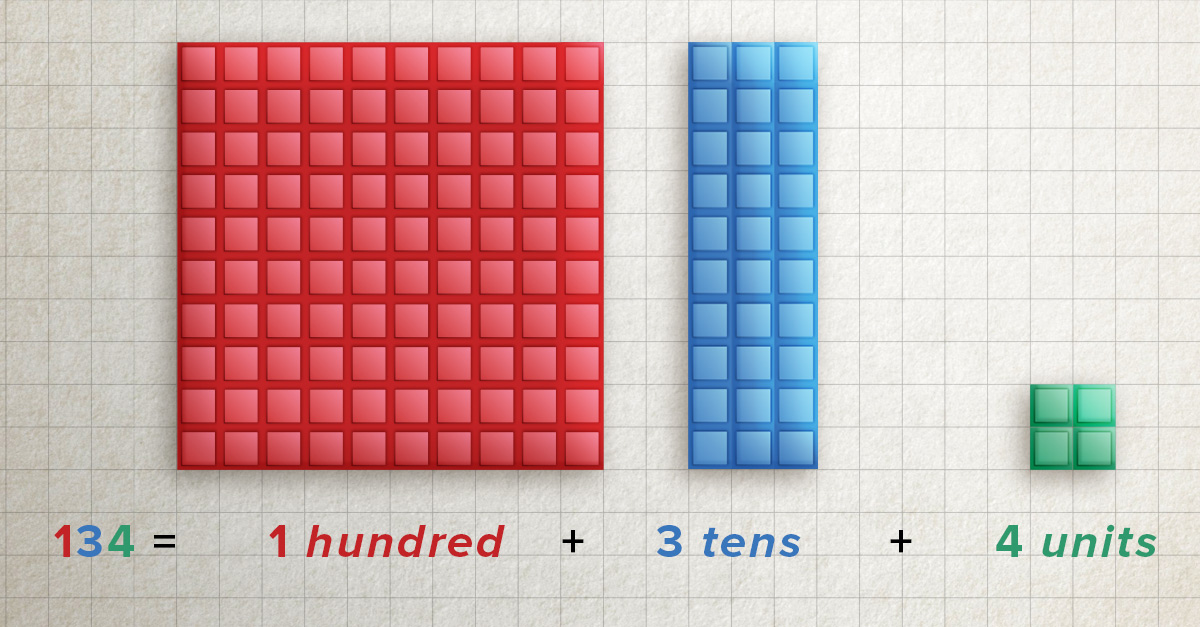Teaching Place Value is Important

The little girl sits puzzling over the problem on the page. She’s only in second grade, but the stress of high performance expectations is already in place. Here’s the problem she needs to solve:
500 – 78
The little girl remembers that she needs to cross out the five and make it a four. She also knows that one of the zeros becomes a nine and the other one becomes a ten, but she just can’t remember which is which, and it’s so frustrating! Finally, she has an idea. She tries different values and adds 78 to each of them until she comes up with:
422 + 78 = 500
She writes 422 as the answer and receives that coveted gold star on her paper. No one knows that she doesn’t understand how to complete this type of subtraction with regrouping (or “borrowing,” as it was called in her day).
I can completely relate to this child’s frustration because that little girl was me. What was the issue? Hint: It wasn’t my faulty memory. It was that I had been taught only an algorithm and had not been provided any conceptual understanding of the role of place value.
What is Place Value?
The definition of place value is rather simple.
Place value is the position of a number that tells what value it is assigned. Here at Demme Learning, we often say place value tells “what kind” or “what value.” This is in contrast to the digits 0-9, which indicate “how many.” For example, in the number 246, the digit 4 indicates there are four (how many) tens (what kind/place value).
Despite its simple definition, place value can be a challenging concept for a young child to grasp. Regardless of whether dad is in the kitchen, the living room, or the garage, he is still dad, but if the digit 3 is in different locations (tens or hundreds place, for example), it means something different. In the Math-U-See curriculum, place value is first introduced in the Primer level with the fun and relatable illustration of Decimal Street®. Each of the houses on Decimal Street represents a separate place value. This is reiterated in the Alpha level and again in Beta.
Why is Place Value Important?
From the opening story, you saw that place value has some impact on mathematical understanding, but how important is it?
According to Sherman, Richardson, and Yard, “Place value is perhaps the most fundamental concept embedded in the elementary and middle school mathematics curriculum.”4 Place value provides the foundation for regrouping, multiple-digit multiplication, and more in the base-ten (decimal) system, as well as a starting point for the understanding of other base systems.
Place value allows your 12-year-old son to understand the difference between the $50 he received for his birthday and the $500 price tag on the tablet he’s saving for.
Place value allows the student learning scientific notation to understand why 54,800,000 can be represented as 5.48 X 107.
Studies have shown that place value understanding has a positive correlation with overall mathematics achievement.2 As a second-grade student, place value would have helped me understand that when I crossed out the 5 in 500, I was really decomposing 1 hundred into 10 tens, of which 1 needed to go to the ones or units place to allow me to subtract, leaving 9 to go to the tens place. There would have been no need to memorize (and forget) an algorithm!
Hopefully you are convinced that place value is important, but does it really matter how it is taught?
Research has shown a correlation between using base-ten manipulative representations of numbers (as opposed to one-to-one representations) and understanding of place value.2 In other words, representing the number 24 with two 10 blocks and four units rather than 24 units correlates with a better understanding of place value.
The Math-U-See presentation of place value using Decimal Street and our color-coded pieces for units, tens, and hundreds supports this desired base-ten representation. Additionally, studies have shown that the way numbers are verbalized by English-language speakers may negatively influence the way students think about and represent numbers in comparison to Asian-language speakers.3 Unlike their English counterparts, Asian-language number names correspond directly with the base-ten system. Math-U-See provides some alternate number naming strategies to help bridge this gap and promote better understanding of base ten.
We invite you to watch the video presentation on place value and see how Math-U-See can help your student gain a better understanding of this foundational concept.
Have You Heard About AIM?
Accelerated Individualized Mastery (AIM) provides a new solution for struggling math students with gaps in their foundational math skills set. The AIM programs use proven Math-U-See strategies and manipulatives in combination with an accelerated approach to help students successfully master math concepts.
References
1Kouba, V. L., Brown, C. A., Carpenter, T. P., Lindquist, M. M., Silver, E. A., & Swafford, J. O. (1988). Results of the fourth NAEP assessment of mathematics: Number, operations, and word problems. Arithmetic Teacher, 35(8), 14-19.
2Miura, I. T., & Okamoto, Y. (1989). Comparisons of U.S. and Japanese first graders’ cognitive representation of number and understanding of place value. Journal of Educational Psychology,81(1), 109-114.
3Miura, I. T., Okamoto, Y., Kim, C. C., Steere, M., & Fayol, M. (1993). Cross-national comparisons: France, Japan, Korea, Sweden, and the United States. Journal of Educational Psychology,85(1), 24-30.
4Sherman, H. J., Richardson, L. I., & Yard, G. J. (2014). The impact of place value on mathematics.